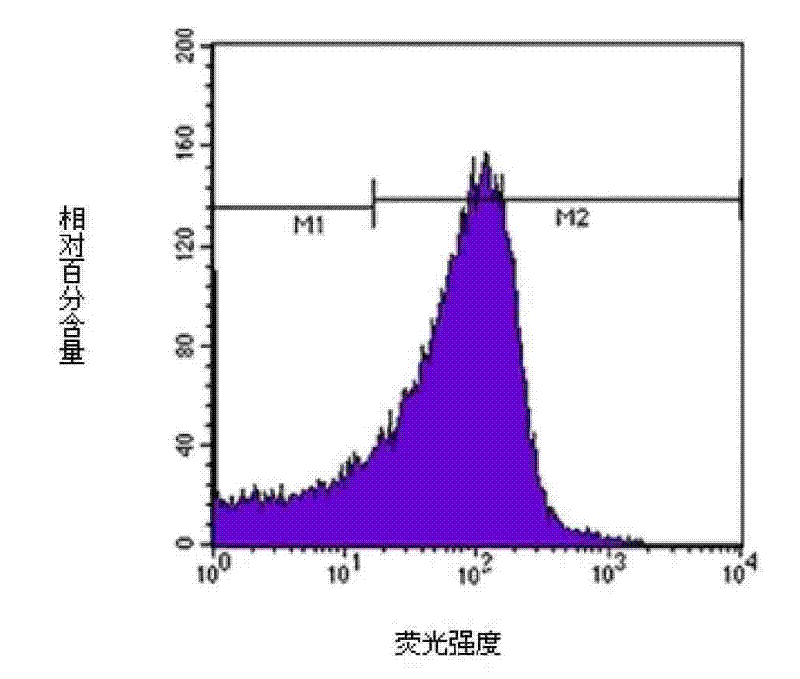Lipid targeted ultrasound contrast agent and preparation method thereof
A contrast agent and targeting technology, applied in echo/ultrasound imaging agents, etc., can solve problems such as poor stability of targeted ultrasound contrast agents, limited selection range of multifunctional reagents, and the influence of changes in the physical properties of the solution. The effect of high probe binding rate, less preparation raw materials and suitable size
- Summary
- Abstract
- Description
- Claims
- Application Information
AI Technical Summary
Problems solved by technology
Method used
Image
Examples
Embodiment 1
[0036] Embodiment 1: The influence of the power and time of probe ultrasound on the preparation of microbubbles:
[0037] Fully suspend 40mg DSPC, 4mgDPPA, 5mg poloxamer in 5ml double distilled water at 40-50℃ to make suspension A; then dissolve 5mg FITC-KGDS-Palm (palmitic acid with fluorescent peptide) Dissolve completely in 200 μl of absolute ethanol at 40°C to make Solution B; Suspension A is sonicated in a probe ultrasonic instrument (work for 3 seconds, pause for 3 seconds, power 30%, 3 minutes), ultrasonic The number of times is once or twice, and the solution B is added dropwise during the ultrasonic process, and the clarity of the obtained solution is observed. The results are shown in the table below.
[0038]
[0039] The clarity of solution C directly affects the concentration and particle size of the prepared microbubbles. The clearer the solution, the higher the degree of molecular dispersion of the lipid components in the solution, the more uniform the part...
Embodiment 2
[0041] Fully suspend 40mg DSPC, 4mgDPPA, 5mg poloxamer in 5ml double distilled water at 40-50°C to make suspension A; then dissolve 8mg FITC-KGDS-Palm in 250μl absolute ethanol, at 60°C Dissolve completely under the condition, make solution B; Suspension A carries out sonication in probe sonicator (work 3 seconds, pause 3 seconds, power 30%, 3 minutes), ultrasonic frequency is once or twice, in ultrasonic process Solution B was added dropwise to the solution, and the obtained solution was observed to be clear.
[0042] The probe polypeptide is KGDS or RGDS, designed and synthesized by 9-fluorenylmethoxycarbonyl (fluorenylmethoxycarbony, Fmoc) solid-phase synthesis method, directly linked to the peptide ligand palmitic acid, purified by high performance liquid chromatography, with a purity > 95%, and identified by mass spectrometry The molecular structure is correct, and the binding ratio of the probe polypeptide to palmitic acid is 1mol:1mol. The probe polypeptide synthesis a...
Embodiment 3
[0043] Embodiment 3: the impact of high shear rate on microbubble yield and particle size:
[0044] Add 5 mg of PEG-4000 into the clear liquid C prepared in Examples 1 and 2, and dissolve completely; pass through perfluoropropane gas to fully saturate the clear liquid C, and at the same time, process the solution C at different shear rates and different shear times, The prepared microbubble suspension particle size and concentration are as follows:
[0045]
[0046] The palmitic acid content of the binding polypeptide in Example 1 is 0.1% by weight of the contrast agent, the content of synthetic phospholipids is 0.9% by weight of the contrast agent, the content of PEG-4000 is 0.1% by weight of the contrast agent, and the content of poloxamer is 0.1% by weight of the contrast agent. 0.1% by weight.
[0047] The palmitic acid content of the binding polypeptide in Example 2 is 0.16% by weight of the contrast agent, the content of synthetic phospholipids is 0.9% by weight of t...
PUM
 Login to View More
Login to View More Abstract
Description
Claims
Application Information
 Login to View More
Login to View More - R&D
- Intellectual Property
- Life Sciences
- Materials
- Tech Scout
- Unparalleled Data Quality
- Higher Quality Content
- 60% Fewer Hallucinations
Browse by: Latest US Patents, China's latest patents, Technical Efficacy Thesaurus, Application Domain, Technology Topic, Popular Technical Reports.
© 2025 PatSnap. All rights reserved.Legal|Privacy policy|Modern Slavery Act Transparency Statement|Sitemap|About US| Contact US: help@patsnap.com



